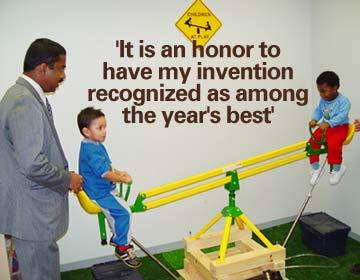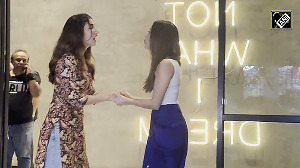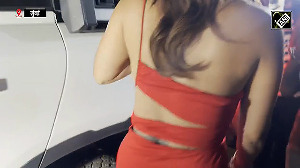
Raj Pandian, Professor, Engineering Computer Science Department, Tulane University, Louisiana, has found a way to use pneumatic cylinders to convert the energy children produce on playgrounds. His invention was among The New York Times Magazine's Outstanding Ideas of 2003. The only Indian on the list -- an amazing achievement for someone who began his education at a municipal school in Tamil Nadu.
Pandian, who developed a prototype when he was with the University of Michigan, put pneumatic cylinders under the seats of a seesaw and connected them to a small tank. As children go up and down, air is pumped through the cylinders, into the tank. After enough air is collected, an inflator converts the energy of the compressed air into electrical power, to be stored in batteries.
At Tulane, Pandian uses his start-up research grant to work on developing other prototypes, according to the online publication Tulane Hullabaloo, such as merry-go-rounds, and wants to find students to get involved. He spoke to Senior Editor Arthur J Pais recently.
Are you tempted to go back to India?
Though politics and bureaucracy in India can be daunting to one contemplating a return to India, compared to merely 10 years back -- when I left India -- conditions in education, industry and the economy have tremendously improved.
What will you be worried about?
While I do experience a 'culture shock' every time I go back to India, having lived in Japan and the United States for many years I now have the maturity to realize that cultural change takes time -- though, hopefully, not so long [as Keynes said, 'In the long run we are all dead']. So, I can visualize going back to India. In that case, I hope to pursue my interests in technology and industry so that I can contribute to the betterment of as many people as I can.
Are you a praying person?
I started out as a deeply religious person, but during college I was more of an agnostic. After marriage, I have become more attracted to spirituality and family values. I pray regularly with my children, and hope it makes them better persons.
Who was your mentor in high school and what life lessons did you learn from the person?
I studied at the Municipal High School, Erode, Tamil Nadu. I had several outstanding teachers. I did not have a mentor, but looking back from my position as a university educator I cannot help being impressed and humbled by their sincere devotion to teaching us in the best possible manner, despite their low pay and poor working conditions in society that was increasingly being materialistic.
What is your family background?
I come from a middle class family that valued education highly. My father Bhagavathi Shunmugham worked in the Tamil Nadu Electricity Board and my mother Seeniammal was a housewife with elementary education.
Would you tell us about the mentoring you received from your parents?
As we had limited wealth, they relentlessly impressed upon me and my siblings [two brothers and two sisters] that education was the only means by which we could have a better future. My father was for a while active in the trade union movement, which nurtured my egalitarian tendencies.
What has been the impact of the article in The New York Times?
The article resulted in much local media attention, and generated correspondence from people interested in commercialization of the idea as well as engineers -- old and young -- who work on similar projects. It is an honor to have my invention recognized as among the year's best. I hope this publicity increases awareness among engineers and scientists, especially from India and other developing countries, about how to find simple appropriate technological solutions -- some of them developed and used in the West decades ago -- to pressing problems in energy, environment, and health.
How did you start working on the invention?
I got interested in human power conversion as a research problem during my work on rehabilitation robotics in Japan. Many people around the world have been trying to use this approach to produce electricity, irrigation, operate wearable computers, and so on. I adapted my work on compressed air systems (pneumatics) to the playful energy generation in schools and other public places.
Are you optimistic it can be implemented in India?
The technology is simple enough that it can be locally developed and used on a small scale. Therefore, in spite of bureaucratic and political
Have you applied for a patent?
Yes. Though I have applied for a patent for the invention, the idea will be free to be used and improved upon for public benefit. This idea can bring young minds like even kids to understand the concepts of energy/engineering.
What are the two or three life lessons you can share with graduate students in India and young scientists anywhere in the world?
Graduate students and young scientists often have pressing reasons to go with the crowd, for career and professional reasons: like the current 'hot' fields are nanotechnology, biotechnology and fuel cells. On the other hand, we can try to find and develop simple and high technologies for the pressing problems facing the poor. Of course, these solutions depend on local social, economic and cultural factors. They are also much more difficult to implement, compared to run-of-the-mill solutions from the lab.
What would you tell them about the rat race?
Even as graduate students and young scientists are in the thick of the rat race they can try to simultaneously work in their free time on such research problems in their 'garage' or in groups similar to those making Battling Robots from junkyard stuff. The Internet can provide useful ideas and work as a uniting force for such groups, similar to the open source movement that produced Linux.
Who inspired you when you were an IIT student?
At IIT Kanpur my supervisor Professor P R K Rao and a few other faculty were instrumental in supporting and sustaining the convictions of a minority of students such as myself that we needed to 'walk on two legs' and not just focus on the latest tech trends in the West.
Who had the most influence on you in Delhi?
During my PhD at IIT Delhi, my supervisor Professor Madasu Hanmandlu supported my student activism and was a role model for how even as you pursue high-tech research you could be self-reflexive on your role as a socially responsible citizen.
Did you always want to go into engineering?
At school I was good at and enjoyed math and science, so engineering was a natural career choice. Once, in engineering college, I was deeply troubled by the fact that much of what I was studying had no immediate relevance or use to the poor(est) (to apply that famous criterion of Mahatma Gandhi). This led me to serious readings in economics and politics, and I briefly flirted with the idea of switching to the social sciences. I still have sustained the social relevance of my research, by working in and writing about economic development, politics and education.
How did your sojourn in Japan prepare for you to come to America?
The Japanese scientists and engineers are highly practical-oriented. My sojourn in Japan introduced me to 'hands-on' engineering, particularly in new technological systems, that I never had during my mainly theoretical pursuits in India. I got married when I was in Japan -- 'arranged marriage'! -- and my wife Meenakshi Vijayaraghavan, a PhD in cancer research was instrumental in my getting more interested in practical, problem solving type of research interests.
I thought moving to America would give me more opportunities to pursue my ideas.
Most professors in American universities have degrees from America. Your story is different, isn't it?
While Meena and I enjoyed our professional and social life in Japan, once our son Sundar came of school-going age, we had difficulty educating him in Japanese. I tried for a faculty position in English-speaking countries like the United States and the United Kingdom. Meena had a research position offered in California so we moved to the US. Soon after, I got a teaching position at the University of Michigan-Flint.
Your son is very young. What is the most important life lesson you have shared with him?
I try to impress upon him that to be human is to be humane, that making the world a better place for all of us is eventually also in our own interest. I also try to impress upon him that education is the major way in which we can all better ourselves.
What are you reading at the moment?
I am reading Paul Krugman's The Great Unraveling: Losing Our Way in the New Century. It is a collection of his articles in The New York Times, some of which I have read at various times. He offers a brilliant, if depressing, analysis of how the recent socio-economic policies in the US have made the situation one of 'the rich are getting richer, the poor are getting poorer.'
Image: Dominic Xavier






 © 2025
© 2025